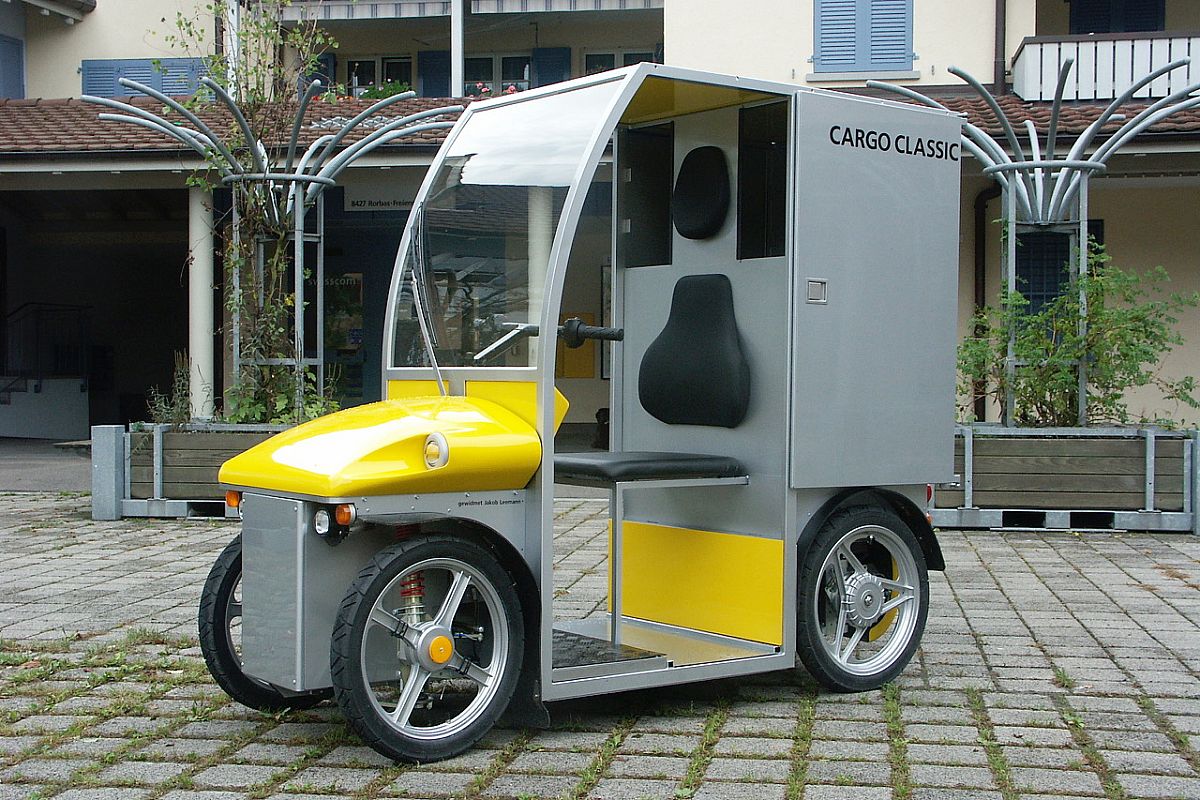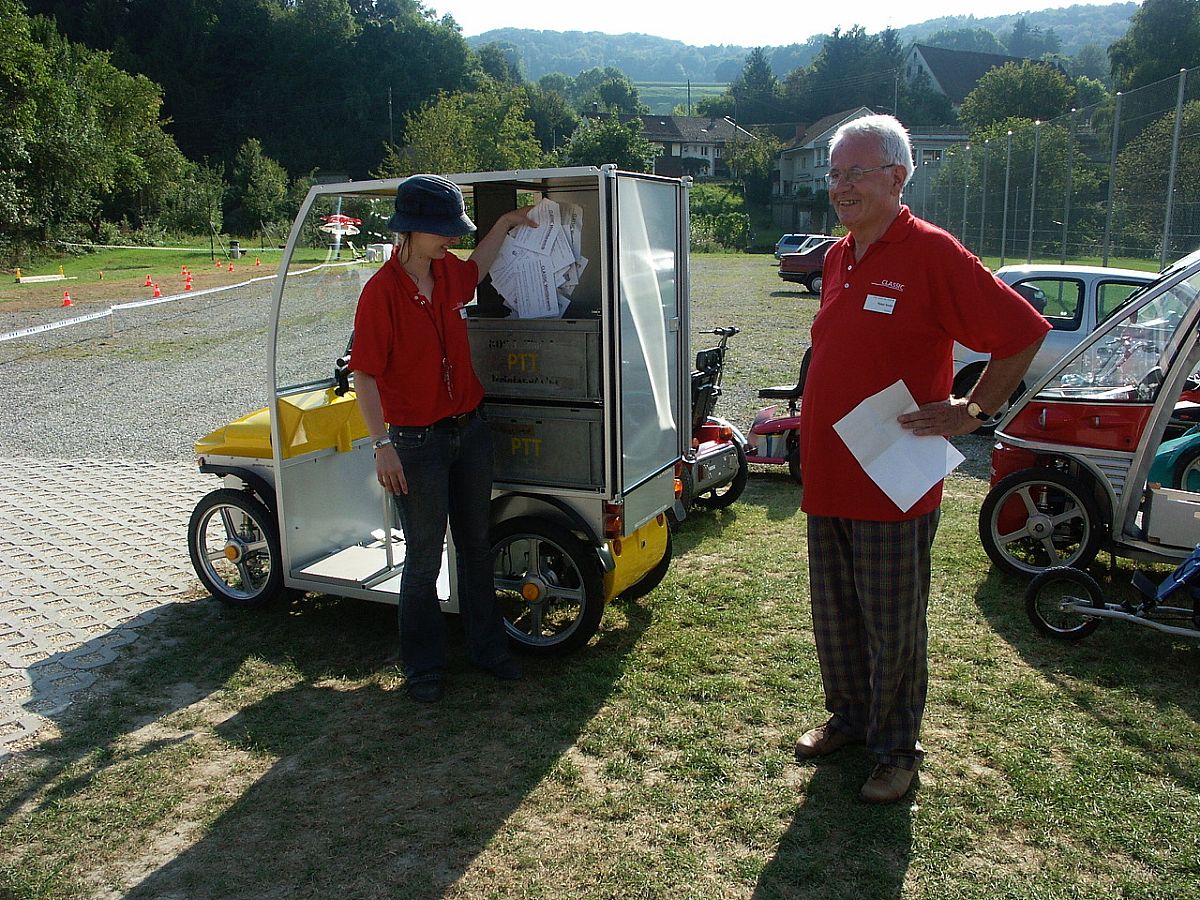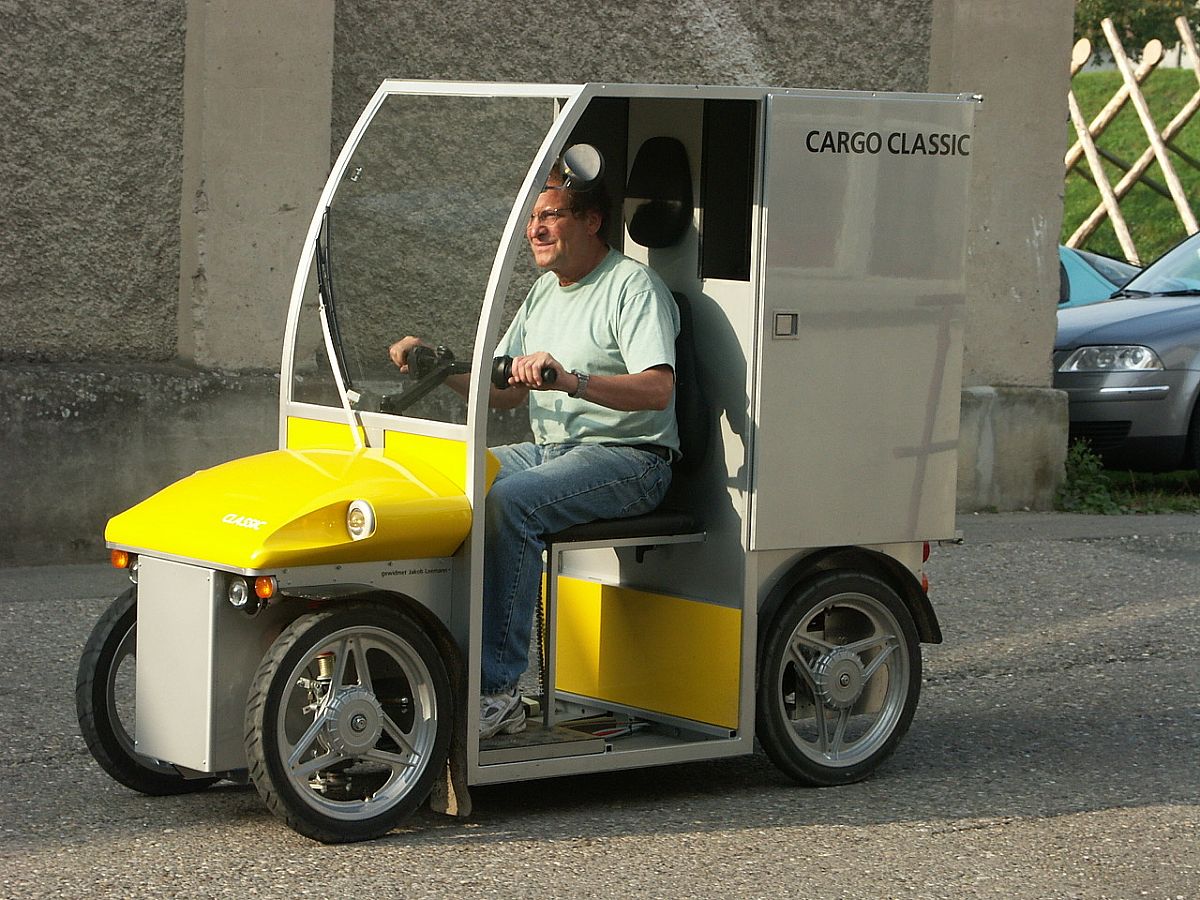Construction of the postal vehicle: The CARGO is created

Stefan Rittler often stayed late at the office in the evening. He seemed to be constructing. I was interested in his project. What was being created? "It was private. He had an idea that he wanted to realise." Aha, the master didn't want to show his cards. That's all right. One should not talk about unlaid eggs. First an idea has to be developed and matured before it can be presented. Some time later, Stefan was in the welding room. He was processing metres of pipes. Obviously his project was in the realisation phase. What would it be? "It's too early, it'll be fine," Stefan reassured me. The skeleton looked strange, like a big cupboard? A little later, Stefan started to mount one of our drives, which came from the CLASSIC 30, into the frame. A front and a rear wheel axle became visible: the frame should obviously drive. Stefan glued plates onto the tubes, a door was inserted. The seat was a simple bench. Again I stood with Stefan in the welding room: a mobile frame? "No, Alima, his wife had taken a job delivering newspapers. He wanted to build a delivery vehicle for her. He is testing a new technique: a very light frame that forms the cabin and storage space. Everything would be covered with Alucobond, a mixture of very thin aluminium sheets filled with plastic. This is used in advertising. This way, he gets the lightest possible construction with maximum stability. It is also very inexpensive." Aha? And the absolutely flat windscreen, which is vertical and reminiscent of the Ford T? "That's the cheapest way to get a windscreen," Stefan instructed me. And mudguards are missing? "It doesn't need them, the vehicle is only supposed to go 20km/h." And lighting? "Whatever is there, the round lamps from the CLASSIC and its rear lights". But just beautiful is different... "Yes, it doesn't need to be beautiful either. It has to be simple and practical. That's all". Obviously, Stefan wanted to continue his project in peace. With the PLUS, it had already been difficult for him. He was all about technology. But I wanted a striking exterior at all costs, and so I commissioned the designer Daniel Johner for design and ergonomics for the project. As a result, it was a constant tug-of-war between Stefan, the engineer, and Dani, the designer. Too often I had to mediate and work towards a compromise. This time, Stefan wanted to give his ideas free rein without having to deal with a designer or me. In his opinion, that was completely overrated. A few weeks later, the frame that had been started stood carelessly in the corner.

Stefan did not continue building. What had happened? "Yes, Alima had taken another job. She doesn't need the vehicle any more". In the following, I walked past the part again and again. The idea with the light frame and the planking had something to it. The frame was also already equipped with a drive axle, a steering system was installed. It was foreseeable that the whole thing would also drive. I made a plan. I asked Stefan if he still had a use for his project. "No, you can have it". Now I began to draw. The thing was already abysmally ugly. It could really only be developed in the direction of "original". The straight windscreen was axed away and replaced by a curved one, mudguards were added, similar to the PLUS, the rear lights were offset, a new rear end and importantly: good lighting, modern, contemporary lighting. Then the main piece: a front fascia, which gave the whole thing a bit of shape and attracted attention. I carved, rehearsed and placed the headlights in the middle at the front, the low beams towards the back, so that they illuminated parts of the front bonnet, further contouring the car. I took the finished mould to the car painter Philipp Mayeux, with whom we had already done a few projects. I got back a beautifully shiny moulded part that I immediately put on the car. The front was still reshaped, some radii were added to the surface and the work could be admired. I was quite satisfied with the joint work. Stefan said: "Well, it's not exactly beautiful either". I agreed with him. The resulting vehicle was no beauty, but very original. A name was needed: CARGO, I couldn't think of a better one. The CARGO drove quite well. It also had an automatic parking brake, which was incredibly practical. The steering force was a bit high, but very precise. The accelerator and brake were operated with the feet, just like in a car. It reached 60 km/h and had a payload of 150 kg. An individual registration was applied for and also granted. We were now officially allowed on the road.

I asked our postman Jimmy Ganz if he could do his job with our CARGO. He was not allowed to. He has to work with his moped, which is provided by the post office. But: he also distributes all the ballot papers for the municipality. He could test the CARGO there. No sooner said than done, a vote was due, and Jimmy picked up the Cargo. When he returned, he was beaming: "That's fantastic." He was making much faster progress. It must have taken him half the time to put all the envelopes in the mailboxes. He could work directly from the vehicle and was lightning fast. That seemed very interesting. Jimmy put in a good word with his boss, the postman Mr Dubach of Rorbas, and on his next errand he asked me to call Mr Dubach. I had an appointment with him. I drove to the post office with the CARGO. For once, he would not stay behind his counter. He came out and looked at the CARGO from all sides. He was very nervous. Was it because of the design that took some getting used to or because it was the first time he received me as a customer in the square behind the post office and not behind his usual counter? He thought about it and said, "Actually, such experiments always have to be approved by the head office in Bern." But if it was just a matter of gaining some operational experience, if I also took full responsibility and Jimmy drove my CARGO of his own free will, he could turn a blind eye. We were allowed to test in practice! I cheered.
Jimmy was very happy with the CARGO. The delivery was much easier for him. He was much safer on the road in winter, he was protected from the rain, he could carry much more load and his work went easily. We were able to gather operational experience, identify weak points and improve them, the CARGO proved itself. Mr Dubach called me: He had received a rebuke from Bern. Somehow it had leaked out that a new type of vehicle was being tested in Rorbas, and that was not acceptable at all. He had to return the CARGO immediately and someone from the post office would contact me. That sounded serious. A little later, Stefan Sigrist from Mobility Solution called. He explained that he worked for the post office. He had been asked to look at my vehicle. A little later he showed up at our house. I described the CARGO to him with all its advantages, including the fact that the postman was extremely satisfied with it. And yes: to be on the safe side, I dedicated the CARGO to my late grandfather Jakob Leemann, who had worked at the post office all his life. I wanted to play it safe.
Stefan Sigrist at least seemed interested. He explained to me that such tests may in principle only be carried out under their supervision, but that he thought it would be sensible to leave the CARGO in service and draw up a report on it. So the CARGO remained in use for several months afterwards. Stefan - we were on a first-name basis by now - showed up from time to time to ask about the status. At the end of the test, he asked me for a quote for 1 CARGO and said he would write the final report. After that, I heard nothing more from him.
In the meantime, I had contacted Deutsche Post. I was allowed to go to Munich to present the CARGO. A lot of interest, yes, that could be something, a few days of testing and a final report there too, which I did not get to see. In the meantime, I had met a Frenchman who picked up the CARGO and presented it at the French Post Office. There, the CARGO was covered with logos of the post office and there were also test runs. Yes, it was an appealing concept. They were interested. And nothing else happened. Surely that couldn't be? The not exactly pretty, but practical CARGO spent the next time in the warehouse, Jimmy fetched it from time to time to get on faster with his work or to hand out ballot papers for the municipality.
Lesson learned:
- A failed project can well become the start of something new.
- There is nothing like practical tests. The users must be allowed to contribute their ideas to the development.
- Being "good" alone is not enough. It needs more.
